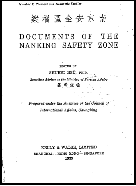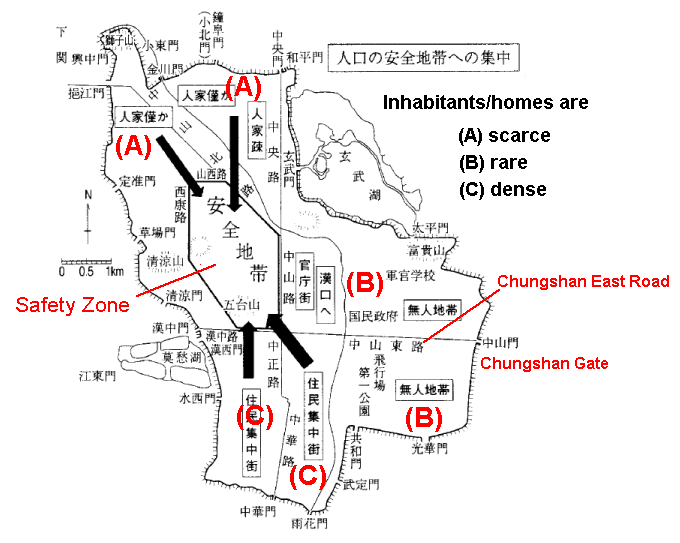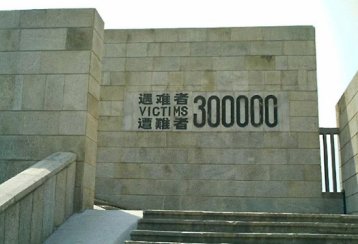| Click the image to get the full text in pdf file. �� |
 |
KASHIMA akira
When the Japanese Army commenced the all-out assault on December 10, 1937, About 40 westerners remained inside the Nanking Castle. 15 of them established the "International Committee" and designated the "Safety Zone" where no military operations should take place.While many Nanking citizens already evacuated to other cities anticipating the coming battle, poor citizens who have no money and/or nowhere to go remained inside the city. On December 8, based on the order of Tang Shen-chi �i�����q�j, Defense Commander, City Mayor Ma �i�n���r�j ordered all remaining citizens evacuate into the Safety Zone. He temporarily delegated his authority of administration for the Safety Zone to the International Committee by providing some money, food and 450 policemen.
After the battle was over and the city was occupied, the International Committee kept sending letters to the Japanese Embassy almost every day, from December 17 to early February, for reporting criminal misconduct of the Japanese soldiers, for asking the release of food storage confiscated by the Japanese Army, and for urging early recovery of water/electricity supply, transportation and other normal daily lives of the city. (Both Japanese Embassy and Japanese Army HQ were located in close vicinity of the Safety Zone.)
Those letters were compiled by Professor Hsu Shushi�i���i��jof Yenching University (������w) and published in May 1939, about one and a half years later since the occupation of Nanking by the Japanese Army.
Since this booklet was "prepared under the auspices of the Council of International Affairs, Chunking �i�d�c�j," as the cover of the booklet says, these letters may be considered as the official understanding of the �gNanking Atrocity�h for the Republic of China.
| Before the Battle of Nanking began, Defense Commander Tang Sheng-chih ordered all the remaining citizes to evacuate into the Safety Zone. Therefore, all the remaining Nanking citizens were concentrated in the Safety Zone. |
 |
| A view from the top of the Chungshang Gate just after the battle (Source: Asahi-graph No. 11). After occupying the gate, the Japanese Army advances on the Chungshang East Road. This photo is consistent with the above description that inhabitants were rare in the eastern side of the Nanking City. |

|

Document No.9 (dated Dec.17, 1937) says that �gwe (International Committee) had nearly all the civilian population gathered in the Zone.�h This description supports the fact that the order of Mayor Ma was successfully observed by the civilian population remained in the city. This means that, if the massacre or mass-killing ever took place, it must be within the Safety Zone or its vicinity.This deductive reasoning starkly contradicts with the description of Document No. 68 (dated Feb.10, 1938), which says �gthe population within the zone according to local Japanese population figures is still 160,000.�h Why did so many people remain in the Safety Zone while they should have experienced the mass-killing of 300,000 by that time ?
 |
A view of Nanking Safety Zone two days after the fall of Nanking. This area is west of the crossing between Chungshan Road and North Chungshan Road. Notice the generally relaxed atmosphere of the town, which is quite contrary to the description of mass-killing by John Magee, Harold John Timperley and Iris Chang. This photo was taken by Mainichi Shinbum Reporter Sato Shinju on December 15, 1937 |
The above photo was taken at the location indicated with  below two days after the fall of Nanking. below two days after the fall of Nanking.
|
 |

Tokyo Trials state that �gWholesale massacres, individual murders, rape, looting and arson were committed by Japanese soldiers. [�c] This orgy of crime started with the capture of the City on the 13th December 1937 and did not cease until early in February 1938. In this period of six or seven weeks thousands of women were raped, upwards of 100,000 people were killed and untold property was stolen and burned.�h (Judgment of 4 November 1948) General MATSUI Iwane, Commander-in-Chief of the Japanese Army assigned to attack the City of Nanking, was found guilty and hanged for the above-stated charges.However, as shown below, all letters and memos that touch upon the population you can find in the "Documents of the Nanking Safety Zone" indicate that the population in Nanking was 200,000 in December, 1937 and 250,000 in January, 1938. (See the graph below)
- How can you kill 300,000 while the population was only 200,000?
- Why did the population increase from December to January by 50,000, should the mass-killing was underway in Nanking? The only logical reason would be that there was no massacre at all and because the battle was over and the peace was restored, the evacuees were returning to the city. (The report of the Nanking Special Service Corps states that the population of Nanking in mid-March 1938 was 380,000.)
 |
This photo was taken on Feb.2, 1938 by Reporter Kageyama and published on March 20 with the caption that says �gEvacuees come back home in a rapid pace and begin to build makeshift homes nearby Hanchung Gate�i������j�h. |
Document No. 9
| Title | LETTER TO JAPANESE EMBASSY |
| Date | December 17, 1937 |
| To | Japanese Embassy |
| From | John H.D. Rabe |
| Excerpts |
On the 13th when your troops entered the city, we had nearly all the civilian population gathered in a Zone in which there had been very little destruction by stray shells and no looting by Chinese soldiers even when in full retreat.
It is hard to see how see how starvation may be prevented among many of the 200,000 Chinese civilians if order is not restored at once among the Japanese soldiers in the city. |
Document No. 10
| Title | LETTER TO JAPANESE EMBASSY |
| Date | December 18, 1937 |
| To | Japanese Embassy |
| From | John H.D. Rabe |
| Excerpts |
We are sorry to trouble you again but the sufferings and needs of the 200.000 civilians
for whom we are trying to care make it urgent that we try to secure action from your military authorities to stop the present disorder among Japanese soldiers wandering through the Safety Zone
We 22 Westerners cannot feed 200,000 Chinese civilians and protect them night and day. That is the duty of the Japanese authorities. If you can give them protection, we can help feed them! |
Document No. 20
| Title | LETTER TO JAPANESE EMBASSY |
| Date | December 21, 1937 |
| To | Japanese Embassy |
| From | The Foreign Community of Nanking |
| Excerpts |
We come to petition in the name of humanity that the following steps be taken for the welfare of the
200,000 civilians in Nanking.
In view of the fact that the looting and burning have brought the business life of the city to a standstill and consequently reduced the whole civilian population to one vast refugee camp, and in view of the fact that the International Committee has reserve food supplies to feed these 200,000 people one week only, we most earnestly beg you to take immediate steps to restore normal conditions of civilian life in order that the food and fuel supply of the city may be replenished. |
Document No. 26
| Title | LETTER TO JAPANESE EMBASSY |
| Date | December 27, 1937 |
| To | Japanese Embassy |
| From | The Foreign Community of Nanking |
| Excerpts |
Since the Chinese military had 100,000 tan of rice (besides our 30,000 tan) in the vicinity of Nanking,
most of which fell into your hands with the capture of Nanking,
we plead that you allow us to get these 20,000 tan for feeding the 200,000 civilians.
(Note) tan �S�Fa unit of quantity one man can carry on his shoulder |
Document No. 41
| Title | LETTER TO MR FUKUDA |
| Date | January 14, 1938 |
| To | Japanese Embassy |
| From | John H.D. Rabe |
| Excerpts | We understand that you registered 160,000 people without including children under 10 years of age, and in some sections without including older women. Therefore there are probably 250,000 to 300,000 civilians in the city. |
Document No. 43
| Title | LETTER TO JAPANESE EMBASSY |
| Date | January 17, 1938 |
| To | Japanese Embassy |
| From | John H.D. Rabe |
| Excerpts |
P.S. Since writing this letter this morning, we learned at noon that regarding point (1) the Japanese authorities have assigned 1,000 bags of rice to the Tze Chih Wei Yuan Hwei,
delivery of which started this morning.
We trust that this amount will be increased to 1,000 bags of rice per day in order to more adequately meet the needs of 250,000 people.
(Note) Tze Chih Wei Yuan Hwei �����ψ��� Nanking Autonomous Government Committee |
Document No. 46
| Title | TELEGRAM TO MR. BOYNTOM |
| Date | January 18, 1938 |
| To | Boynton National Christian Council Shanghai |
| From | Fitch |
| Excerpts | Food question more serious because no regular supply available civilian population. Only twenty-two hundred bags rice one thousand bags flour released for sale from large stocks on hand to two hundred fifty thousand people since December thirteenth. |
Document No. 47
| Title | LETTER YO MESSRS ALLISON, PRIDEAUX-BRUCE AND ROSEN |
| Date | January 19, 1938 |
| To | Allison, Prideaux-Bruce, and Rosen |
| From | John H.D. Rabe |
| Excerpts |
You have each individually expressed a friendly interest of seeing that the 250,000 civilians in this city are fed.
A regular supply of rice to the extent of 2,000 tan (or 1,600 bags) of rice per day, or approximately the same weight of flour. (250,000 at the normal daily consumption of one tan per 100 adults per day would be 2,500 tan per day, but small children in the population would not need so much per day.) |
Document No. 49
| Title | MEMORANDUM ON RELIEF SITUATION |
| Date | January 22, 1938 |
| To | n / a |
| From | n / a |
| Excerpts |
The International Committee for the Nanking Safety Zone is now operating as a relief committee
for the welfare of the 250,000 Chinese civilians living in the city.
It is estimated that it would take 1,600 bags of rice per day to feed the 250,000 people. |
Document No. 54
| Title | LETTER TO MR. PRIDEAUX-BRUNE |
| Date | January 28, 1938 |
| To | Mr. Prideaux-Brune |
| From | John H.D. Rabe |
| Excerpts |
Of the 250,000 refugees in Nanking, a large proportion are homeless due to the extensive burning that has taken place in the city and its vicinity.
But even this $157,000 will not go very far toward relieving the distress among the quarter of a million people now in the city. |
Document No. 68
| Title | MEMORUNDUM OF RELIEF PROBLEMS |
| Date | February 10, 1938 |
| To | n / a |
| From | Lewis S.C. Smythe |
| Excerpts | And the population within the zone according to local Japanese population figures is still 160,000. |


|
|
To the top of this page |
|
|
Return to Home |